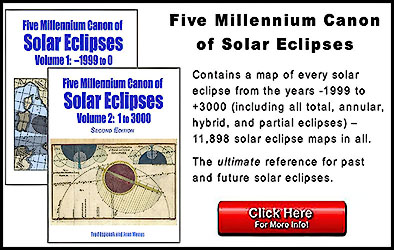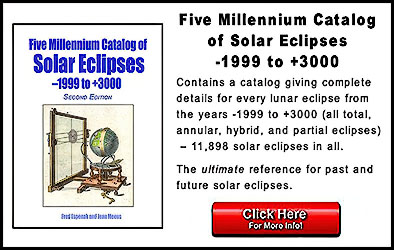Explanation of Umbral Contacts and Extremes for Solar Eclipses
by Fred Espenak
The following tables contain brief explanations for the various contact times of the Moon’s umbral or antumbral shadow with Earth’s surface during an eclipse of the Sun.
| Contacts of Umbral Shadow with Earth | ||
| Contact Event | Contact | Description |
| First External Contact | U1 | Instant of first external tangency of the umbral or antumbral shadow cone with Earth’s surface
(edge of umbral or antumbral shadow first falls on Earth - total or annular eclipse begins) |
| First Internal Contact | U2 | Instant of first internal tangency of the umbral or antumbral shadow cone with Earth’s surface
(entire umbral or antumbral shadow first falls on Earth) |
| Last Internal Contact | U3 | Instant of last internal tangency of the umbral or antumbral shadow cone with Earth’s surface
(entire umbral or antumbral shadow last falls on Earth) |
| Last External Contact | U4 | Instant of last external tangency of the umbral or antumbral shadow cone with Earth’s surface
(edge of umbral or antumbral shadow last falls on Earth - total or annular eclipse ends) |
| Extreme Northern and Southern Path Limits of Umbra | ||
| Contact Event | Contact | Description |
| North Extreme Path Limit 1 | N1 | Northern limit of the umbral or antumbral shadow at the start of the central path |
| South Extreme Path Limit 1 | S1 | Southern limit of the umbral or antumbral shadow at the start of the central path |
| North Extreme Path Limit 2 | N2 | Northern limit of the umbral or antumbral shadow at the end of the central path |
| South Extreme Path Limit 2 | S2 | Southern limit of the umbral or antumbral shadow at the end of the central path |
| Extreme Limits of the Central Line | ||
| Contact Event | Contact | Description |
| Extreme Central Line Limit 1 | C1 | Starting point of the central line on Earth's surface |
| Extreme Central Line Limit 2 | C2 | Ending point of the central line on Earth's surface |




